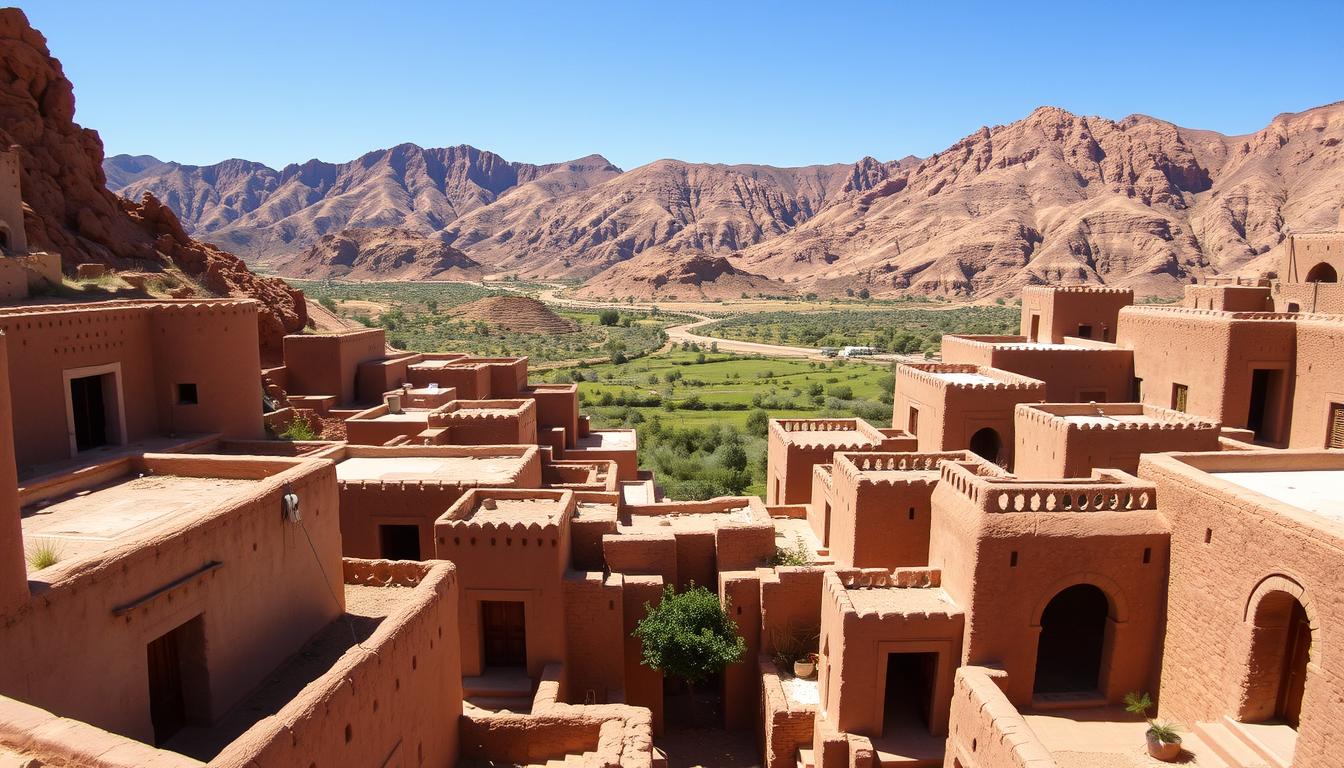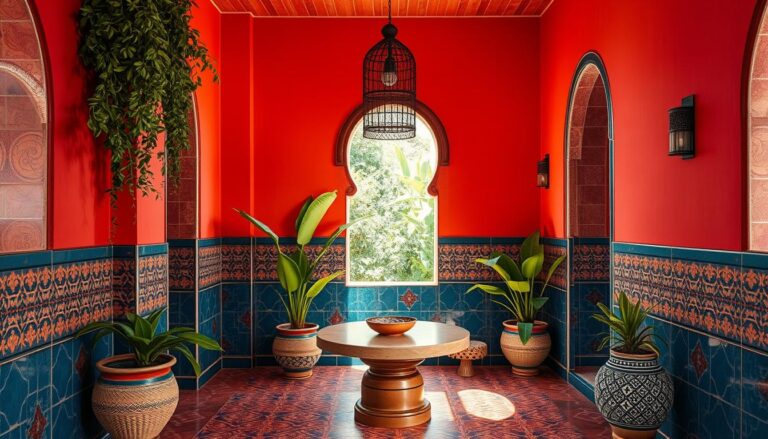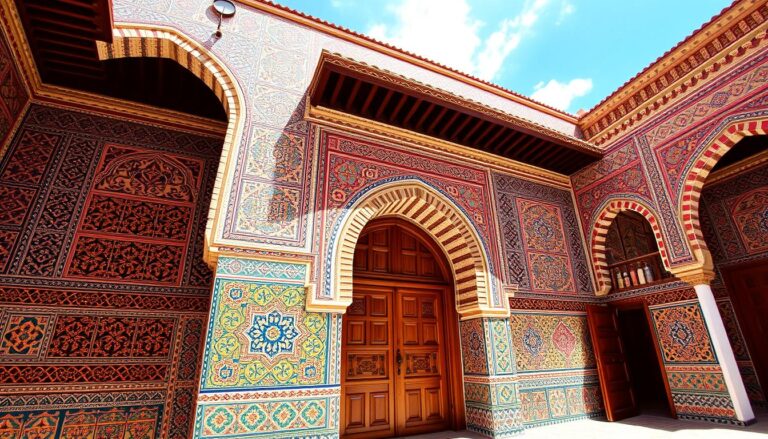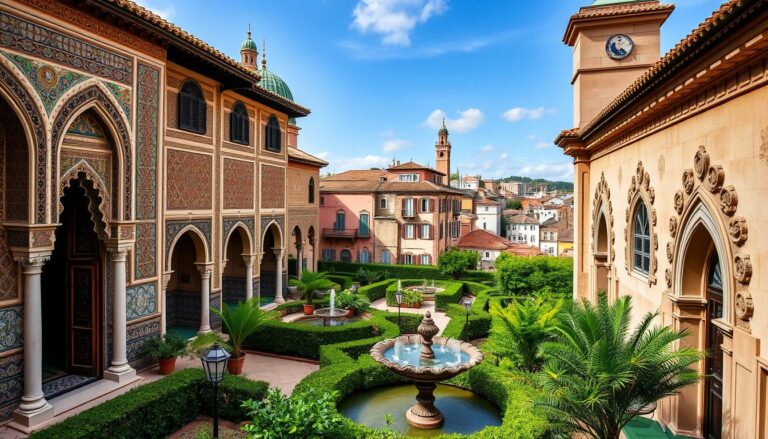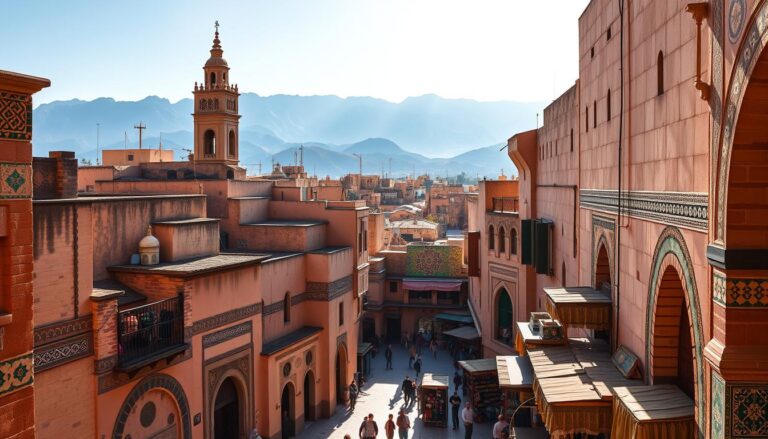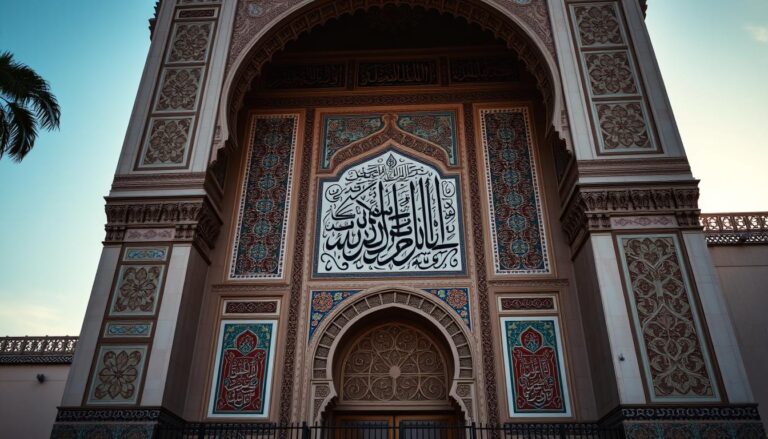What secrets hide in Morocco’s ancient earthen fortresses and colorful tilework? Explore how the Berber, or Amazigh, people have shaped the country’s architecture. Their influence is a big part of Morocco’s rich history.
Key Takeaways
- Moroccan architecture shows the mix of cultures that have influenced the country over time.
- Berber or Amazigh styles are known for their traditional earthen buildings and fortified villages. These are found in places like the Atlas Mountains and the Sahara.
- The Koutoubia Mosque in Marrakesh is a great example of Amazigh design. It has a unique square minaret.
- Moroccan artisans, known as “Maâlems,” keep old building methods and crafts alive.
- The Moroccan government is working hard to protect the country’s architectural heritage. They do this through cultural preservation efforts.
Berber Kingdom: Origins of Moroccan Architecture
Morocco’s architecture comes from the Berber kingdoms that ruled the area long ago. The Berber kingdom of Mauretania started in the second century BC. It left a lasting impact on Morocco’s buildings.
At the center of this kingdom was Volubilis. It was the Mauretanian capital for many years.
Kasbahs and Ksours: Fortified Villages and Trading Posts
In Volubilis, the streets followed a grid plan. The city might have had a palace and walls. The Punic culture also influenced its buildings.
Outside Volubilis, the Berbers built big ports and trading places. They called these kasbahs and ksours. These are found in the Atlas Mountains.
Mudbrick Construction Techniques and Geometric Patterns
Berber buildings in Morocco use pise, or sun-dried mud bricks. These mudbrick techniques and geometric patterns are seen in the Atlas Mountains’ kasbahs and ksours.
“The influence of Punic (Carthaginian) culture in the city is archaeologically attested.”
The Berber kingdoms of Mauretania started Morocco’s unique architecture. They mixed local styles with Mediterranean influences. This rich history still shapes Morocco’s buildings today.
Islamic Influence: Blending Amazigh and Arab Traditions
In the 8th century, Islam changed Morocco’s buildings. The Idrisid dynasty made Fes a key place for politics and culture. This was the start of a new era in architecture.
The al-Qarawiyyin and Andalusiyyin mosques in Fes are famous. They show the “Moorish” arch, a sign of Moorish architecture. These buildings mix Amazigh and Arab styles, making them beautiful.
Moroccan Islamic architecture is known for its beauty and function. It uses Zellij tilework and Islamic fountains. These fountains are like a piece of paradise, helping Muslims prepare for prayer.
“Moroccan architecture showcases a blend of influences from the Berber Kingdom, Islam, Moorish Spain, and French occupation.”
The Idrisid dynasty Fes helped shape Morocco’s architecture. Their work still inspires people today, showing the beauty of Moorish architecture.
Almoravid and Almohad Dynasties: Establishing Iconic Styles
The fall of the Cordoban caliphate in the early 11th century opened the door for the rise of major Berber empires in Morocco. The Almoravids (1054-1147) and the Almohads (1130-1269) were two such empires. They played a key role in shaping Moroccan and Moorish architecture, laying the groundwork for many iconic forms and motifs.
Mosques, Minarets, and Ornamental Gateways
The Almoravids took inspiration from al-Andalus and brought in new ornamental techniques from the east. Their mosques, like the Kutubiyya and Tinmal, are seen as the first Moroccan mosques. These mosques are known for their monumental minarets and ornamental gateways, which became a common style in the region.
Gardens and Palaces: Marrakesh’s Architectural Heritage
The Almoravid and Almohad eras saw a rise in garden estates in the countryside of Marrakesh. The Menara Garden and the Agdal Gardens are prime examples of this architectural style. They showcase the lasting impact of Almoravid and Almohad architecture on the city.
“The Almoravids and Almohads promoted the tradition of establishing garden estates in the countryside of their capital, Marrakesh, which became a hallmark of the city’s architectural heritage.”
Marinid Dynasty: Refining Moorish and Andalusian Influences
The Marinid dynasty ruled from the 13th to the 15th century. They built on the Moorish and Andalusian styles that came before. Their work added to Morocco’s rich architectural heritage.
They mixed Berber, Islamic, Moorish, and Andalusian designs in a unique way. This blend created a lasting beauty in Moroccan buildings.
The Marinids kept up the traditions of earlier Berber empires. They built fortified palace areas, like the Kasbah of Marrakesh. They also made grand mosques, beautiful gateways, and lush gardens.
These buildings showed off their skill in mixing Moorish and Andalusian styles. This period was a peak in Moroccan architecture.
The Marinid dynasty left a lasting mark on Morocco’s architecture. Their work, along with the Almoravid and Almohad styles, makes Moroccan buildings special. Today, these buildings attract visitors from all over the world.
Source Links
- Islamic, Berber, and Modern Influences in Architecture of Marrakesh
- Exploring the rich art, architecture, and craftmanship of Morocco – SA Expeditions
- Exploring the Richness of Moroccan Architecture – Cindrebay
- From Islamic to Art Deco: A rich history of Moroccan architecture
- Moroccan architecture
- The Rich and Vibrant History of Moroccan Architecture.
- Moroccan Cultural Fusion: The best Blend of Influences
- Almoravids | Berber Dynasty, Islamic Empire, North Africa | Britannica
- Almohads | Berber Empire, Islamic Spain, North Africa | Britannica
- Moorish architecture
- Aportaciones magrebíes a la arquitectura universal

The Editorial Team is a passionate group of Morocco enthusiasts dedicated to sharing the beauty, culture, and wonders of this captivating country. With diverse backgrounds and a deep love for travel, we strive to bring you engaging and informative content that inspires your Moroccan adventures. From uncovering hidden gems and sharing local insights to exploring mouthwatering cuisine and showcasing the vibrant lifestyle, our team is committed to providing you with valuable resources and exciting stories that enhance your exploration of Morocco. Join us on this journey as we celebrate the rich heritage and unforgettable experiences that make Morocco truly special.

